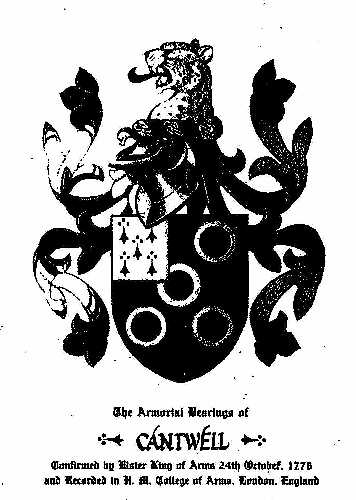
The Armorial Bearings of Cantwell
Published by the Cantwell-Conteville Family Association
and devoted to reporting
on and research about the Cantwell Family
|
Herluin was the first de Conteville because, about 1035 he was given the small vicomte of Conteville by Duke William of Normandy. Herluin married Herleve, the mother of Duke William who became King of England on December 25, 1066 as the result of his army defeating Harold Godwineson at the Battle of Hastings.
The father of Herleve was Fulbert, a tanner in Falaise. Fulbert became a cubicalarius or chambellan in the ducal household. Osbern and Walter were brothers of Herleve. Walter is stated to have watched over the future Conqueror during his perilous childhood and to have saved his life in one instance by snatching the young lad from his cot and evidently hiding him in the home of poor people.
William the Conqueror was born out of wedlock, the son of Robert I, duke of Normandy. He was born at Falaise to Herleve who lived in that town. William had a sister Adelaide, probably of the same parentage. William the Bastard was buried in the church of St Pierre which he had built at Caen in the 11th century.
After the birth of William in 1028, Herleve was married, in about 1035 to Herluin, vicomte of Conteville, and they had two important sons, Odo, bishop of Bayeux, 1049 - ca 1099 and Robert, Count of Mortain who became holders of large amounts of land in eleventh century England. Odo was subsequently the Earl of Kent (also Oxford, Hampshire, Buckingham as Robert was Earl of shires in southwest England (Somerset, Devon, Cornwall to name some).
Herleve died about 1050, after which Herluin married Fredesendis who bore him two sons, Ralph and John, and a daughter who married Lord William of La Ferte-Mace, a village twenty-five miles from Conteville, see page of "william the Conqueror" by David C. Douglas, which shows this daughter as of Herleve. Ralph was perhaps the Radulfus de Contivillo who held lands in Somerset and Devon in 1086 (as shown in the Doomsday Book).
Herluin, vicomte of Conteville, his wife Herleve, and his son Count Robert of Mortain, founded the Abbey of Grestain, across the River Seine from Le Havre. Listed in "Compagnons De Guillaume A La Conquere De L'Angleterre En MLXVI" are Raoul de Conteville and Robert, Comte of Mortain. These "Compagnons" were with the Conqueror at the Battle of Hastings in 1066.
From "Civilizing the Seine" April 1982 issue of the National Geographic, page 481 "This is the gate to France. More than a thousand years ago, Vikings sailed into this estuary. They married themselves to the girls of the region and to the fat land, and Norsemen became Normans. Just upriver, lies Conteville, where a bastard son of the Duke of Normandy, afterward to be known as William the Conqueror, may have spent part of his childhood...".
Gene R. Cantwell of Clayton, New York mailed us a short filmstrip from the Archives in France, which we had transcribed from early French handwriting into modern French by Madame M. Audin of Paris. The translation of one- frame of" the film of a document from the eleventh century reads as follows:
CONTEVILLE: The aforenamed Odon was released by orders of the dying William the Bastard, from Duke R obert Notre Dame de Bayeux, helped by the monks at the church of St Riquet, he stayed in Syria with the aforenamed Robert in the year 1036...
Jean left the company of Duke Robert and Count William the Red and went on to England where he wrote about rebellion, where he was hunted with the risk of his life, for this. ... Robert had his brother Henry put in prison, had King Phillip marry Bertrande of Montfort, who had unjustly abandoned her husband and...church of Meste, went on to Syria with duke Robert in 1036 ...to Palermo where lay the Bishop of Evreux who was buried in the Church of Ste. Marie.